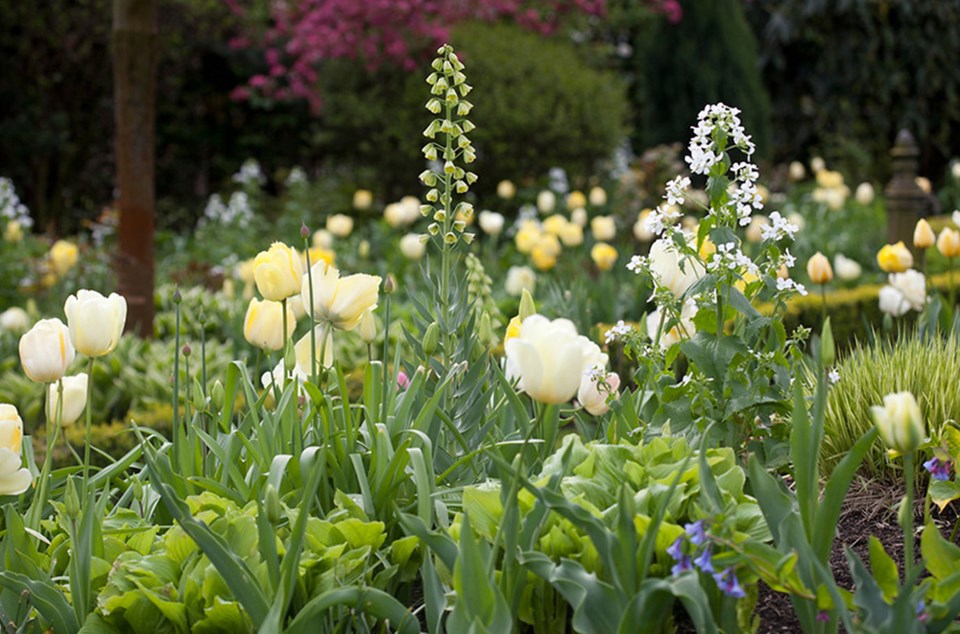As we begin planning our late winter, spring and early summer bulb displays, remember: it’s not only about the bulbs, but also about the effect they can create in our gardens.
It’s a huge waste of ‘bulb talent’ to simply plunk them in here and there. Their brief blooming period is nice, but their die-down time is not. Combining them with complementary companions is a wonderful way of enhancing their own beauty and creating some stunning artistic displays.
As an added advantage, the companion plants will cover up any unsightly foliage as the bulbs’ above-ground time draws to an end, thereby keeping planting areas looking fresh.
As for the bulbs themselves, they will be secure, tucked in among their companion plants, and protected from garden tool damage as we weed and change our seasonal displays, and this is a huge bonus.
Most bulbs will also benefit from the root systems of other plants drawing away excess moisture during periods of heavy rainfall. Many companion plants, like euphorbias, protect bulbs from rodents.
The benefits of companion planting are numerous, so let’s create some great bulb synergy.
Heucheras, heucherellas and tiarellas are evergreen perennials that provide year-round colour.
They now come in a wide range of colours, and many varieties produce attractive flowers in spring. When minor bulbs, like crocuses, muscaris, grape hyacinths and late blooming scillas, are planted among them, these combination plantings create lovely displays, especially when these perennials begin their season with colourful new foliage.
From their rich dark burgundy, black and tan-coloured leaves to my favourite hot limes, you can colour match and contrast them with white, pink, yellow or blue bulb blooms to achieve the effect you want. Miniature daffodils, like Golden Bells narcissus and Tete-a-Tete, work in nicely too.
All these bulbs will not only repeat their flowering next year but will create a more significant display as the bulbs multiply.
Hostas and ferns also make great companion plants, and although hostas die back in winter, many ferns, like Polystichum setiferum, are evergreen and are natural accompaniments for minor bulbs.
In sunny areas, the many varieties of euphorbias make great companion plants. Euphorbia characias and E. Shorty are particularly great options.
These evergreen varieties perform spectacularly year after year and provide wonderful accents for all bulbs. When their vibrant chartreuse flowers open up in late winter, another layer of beauty appears.
Teamed up with compact white narcissus, such as Thalia, or with early single red, white or yellow tulips, they would be showstoppers.
Darker foliage varieties, like Euphorbia amygdaloides, would make great partners for soft yellow narcissus and tulips.
Even the herbaceous varieties, like E. polychroma and E. griffithii, which die back in winter, would create a stunning display with February Gold narcissus, especially as the new red growth begins to open.
Evergreen ornamental grasses, too, offer a great opportunity for bulb pairing.
I love blue fescues, especially the very intense blue of F. Beyond Blue, combined with white snowdrops, blue and purple crocus and blue muscari. Together they create a beautiful effect. Evergreen, compact, upright Acorus gramineus Ogon, with its gold and green stripes, is a delight planted with blue-striped or purple crocus, deep blue muscaris and late flowering blue scillas. For real pop, try short, red botanical tulips, like Tulipa praestans Unicum. Low-growing black mondo grass (Ophiopogon Nigrescens) interplanted with early white minor bulbs, like snowdrops, white-striped, blue puschkinias or white scillas, is pure magic.
Winter-flowering heathers are a natural partner for early colour. The low-growing varieties of Erica carnea, like Golden Starlet and Kramer’s Red, create quite a sight when paired with white, yellow, or blue crocuses and miniature white or yellow narcissus.
The opportunities to create some amazing bulb combinations, using perennials, shrubs, and groundcovers, exist throughout our gardens. Don’t miss the chance to enjoy some really special displays in late winter and spring.



